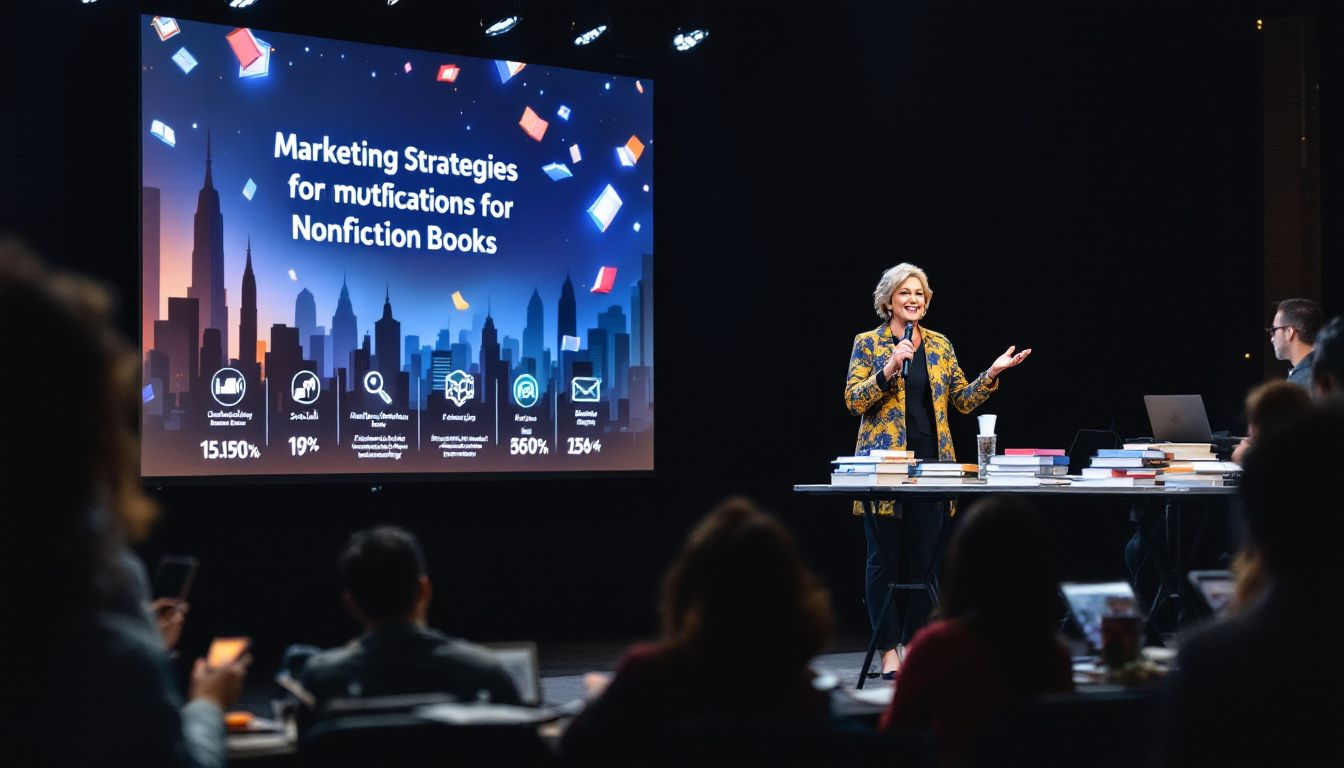How to Write Nonfiction Book: A Practical Guide for Aspiring Authors
Dec 05, 2024
Mastering How to Write Nonfiction Book: Step-by-Step Guide for Success
Do you aspire to write a non-fiction book? In this post, we'll cover what you need to know each step of the way.
Key Takeaways
-
Thorough research is essential for the author's credibility and sets the foundation for a reliable nonfiction book.
-
Craft a detailed outline to organize ideas and maintain a logical flow, making the writing process smoother.
-
Engage in effective marketing strategies and give yourself time to prepare to ensure a successful book launch.
-
Transition into the full writing phase after you've done thorough research and have an outline with structured ideas to form the final manuscript.
Defining Your Nonfiction Book Project
Before diving into the writing process, clearly defining your nonfiction book is crucial. Knowing what success looks like with your book will guide you every step of the way and prevent delays. Start by asking yourself a few key questions:
-
What is the main purpose of my book? Are you looking to educate, entertain, or inspire your readers? Understanding your primary goal will shape the content and tone of your book.
-
Who is my target audience? Identifying your readers will help you tailor your message to their needs, interests, and aspirations.
-
What do I want my readers to take away from my book? Think about the key insights or lessons you want your readers to walk away with and apply.
-
How will my book benefit my readers? Consider the value your book will provide and how it will solve problems or meet the needs of your audience.
You’ll create a clear vision for your project by answering these questions. This clarity will help you stay motivated and ensure that your book resonates with your readers.
Remember, your goals might include educating, entertaining, or inspiring your audience. Keeping these objectives in mind will set guardrails as you move through each step of the writing process.
Choosing Your Nonfiction Book Topic
Selecting the right topic for your nonfiction book is a pivotal decision that will kick-start you on your writing journey. Choose a topic that you’re passionate about, and that will hold the interest of your target audience. Here are some tips to help you make the right choice:
-
Identify your area of expertise: Reflect on what you know well and what excites you. Your passion and knowledge will help your stories and chapters stand out and keep your writing and your readers engaged.
-
Research popular topics: Check bestseller lists, browse online forums, and explore social media to see what subjects are currently trending. This can give you an idea of what readers are interested in and what areas to focus on the most.
-
Validate your idea: Use tools like Amazon’s Kindle Spy, Quora, or Google Trends to gauge the demand for your topic. This will help you ensure there’s a market for your book.
-
Consider your target audience: Think about the problems your readers face and how your book can help solve them. A topic that addresses their needs will be more appealing, especially if that problem needs an urgent solution.
Choosing a topic that aligns with your passion and has a clear demand will make you more likely to write a book that resonates with your readers. This alignment will also keep you motivated and engaged throughout the writing process.
Understanding Nonfiction Book subgenres
Nonfiction books come in various subgenres, each with unique characteristics and appeal. Understanding these subgenres will help you determine the tone and style of your book. Here are some common nonfiction subgenres to consider:
-
Memoir: A personal narrative focusing on a specific aspect of the author’s life. Memoirs are often intimate and reflective, offering readers a glimpse into the author’s experiences and insights.
-
Autobiography: A comprehensive account of the author’s life, usually written in a formal tone. Autobiographies cover a broader scope than memoirs and provide a detailed chronicle of the author’s journey.
-
Self-help: Books that offer advice and guidance on how to improve one’s life or overcome challenges. These practical and motivational books aim to empower readers with actionable strategies.
-
How-to: Books that provide step-by-step instructions on how to accomplish a specific task or achieve a particular goal. How-to books are straightforward and instructional, making complex processes accessible to readers.
-
Narrative nonfiction: Books that tell a true story using literary techniques such as dialogue and description. Narrative nonfiction combines factual accuracy with compelling storytelling, making it engaging and informative.
-
Business books: Focused on professional growth, industry insights, or entrepreneurial strategies, they aim to educate and inspire readers to succeed in their careers or ventures. These books can range from practical guides and case studies to thought leadership and trend analysis, often blending expertise with actionable advice.
By understanding the different nonfiction subgenres, you can choose the one that best fits your book and tailor your writing style accordingly. This will help you create a book that informs and captivates your readers.
Research Fundamentals

Diving deep into research is crucial for creating a successful nonfiction book for any nonfiction writer. The integrity of your work hinges on accurate and reliable research, as even small inaccuracies can damage the trust readers place in you. Thorough research sets your writing apart by establishing it as a reliable and authoritative source. This endeavor goes beyond mere data collection. It’s integral to establishing credibility with your target audience.
A compelling non-fiction narrative gains strength from leveraging primary sources like interviews and original documents for direct insights alongside secondary resources such as critiques and scholarly articles that provide broader perspectives. To enhance the richness of content within your book, employ an assortment of each—including digital databases and personal interviews. It's really important to look at these materials to ensure there's no bias or misleading info sneaking in.
By holding yourself to high ethical standards across varied methodologies, you uphold reliability and signal to others that precision matters greatly in what you present. Imposing deadlines for completing research combats delay tactics, ensuring steady progress toward completion.
The process entails much more than amassing snippets of knowledge—weaving them into a coherent story that resonates with readers while imparting meaningful understanding—preparing one confidently for crafting a well-structured outline that becomes indispensable moving forward.
Crafting a Detailed Outline

Creating a detailed outline is pivotal to maintaining flow and structure in your nonfiction book, making the writing process more manageable. A detailed outline is essential for keeping your nonfiction book organized and flowing smoothly, making the writing process much more manageable. This planning acts as a structured framework that keeps you focused from start to finish. When you begin writing, a detailed outline is a helpful guide, providing a clear path to follow.
Kick off your outline by pinpointing key concepts and arranging them using bullet points or numbered lists for every chapter and segment. This technique helps you picture the book’s overall design while ensuring sufficient content per subject area. You establish a definitive direction for each section by devising an outline before composing your first draft.
Another approach is visually displaying your ideas using mind maps or color coding to arrange and organize your ideas easily. Utilizing index cards can be helpful when it comes time to tweak and reorder parts as necessary. These strategies offer a bird's-eye view of your work, ensuring its structure is logical and engaging.
Armed with this comprehensive plan, you can confidently face the blank page. Start writing your first draft, using your detailed outline as a roadmap to guide you through each stage of the process. Stay aligned with your goals as you craft each section.
Writing the First Draft

With your preparation in place, it’s time to start writing and begin composing your initial manuscript. Concentrate on transcribing your concepts onto paper and resist the urge for immediate perfection. To ensure that each segment captivates and flows well, map out a mini-outline for each chapter highlighting its beginning, conclusion, and pivotal moments.
Prepare yourself for challenges like creative stagnation or a decline in motivation as you begin writing. Overcome these obstacles by following a consistent daily routine and setting specific goals, such as achieving word count targets. Striving to create an initial draft of around 35,000 words can help maintain your motivation.
Embracing authenticity can let your unique tone resonate within your work, making it more appealing. Avoid critiquing or refining what you write when drafting initially—especially when writing fiction. Doing so could impede progress and quash inventive energies—direct attention toward laying down ideas now with plans to polish later during actual editorial phases.
Using storytelling techniques can boost your nonfiction text's appeal by making those dense topics more relatable. It's about turning facts into engaging stories and throwing in lively dialogue where it fits. The key here is to build a solid foundation with plenty of raw insights when you're writing non-fiction. You'll shape and refine it as you hone your writing skills, especially if you're focusing on nonfiction genres.
After completing this primary version, the first draft, one should progress onward, perfecting through several iterations.
Revising and Self-Editing
During the writing phase, the transition from a first draft to a refined manuscript is where you can be a perfectionist. The process involves meticulous self-editing, obtaining insights from beta readers, and enlisting the expertise of a professional editor.
Maintaining consistency throughout your text, removing unnecessary repetitions, and guarantee factual accuracy is imperative. This stage demands dedication as you focus on enhancing the appeal and reliability of your work.
Initially, tackle revisions by rigorously evaluating every part of your writing for potential enhancements or areas needing clearer expression. Aim for succinctness and lucidity in revising your language.
Following rigorous self-editing efforts comes soliciting feedback: hand over this improved draft to beta readers who can provide invaluable perspectives before progressing with editing stages handled by a seasoned editor.
Seeking Feedback from Beta Readers
Beta readers offer critical perspectives on your manuscript’s emotional appeal and the effectiveness of its storytelling, in contrast to the more technical focus of proofreaders. You can steer their input by posing pointed questions about specific concerns.
A group of approximately five beta readers allows you to balance varying viewpoints without becoming overwhelmed. Gathering their feedback into clear categories makes it easier to spot common issues that need attention, helping you focus on the key areas for improvement when revising. Streamlining this process ensures you make the most impactful changes.
Joining a writing group can also be a great way to get helpful feedback from fellow writers, boosting your manuscript before you consider hiring a professional editor. Joining a writing group can also provide valuable feedback from peers, enhancing your manuscript before considering professional editing services.
Implementing all suggestions isn’t mandatory. Prioritize observations congruent with your story’s intended direction and amend accordingly. Always remember to appreciate your beta readers for dedicating time and insight to enhancing your book’s journey from concept to completion.
After making the necessary tweaks from beta reader feedback, it's time to give your manuscript that final polish before publishing it. This is where a professional editor becomes your best friend, helping to fine-tune your work even further.
Professional Editing
Professional editing transforms your manuscript into a marketable product by enhancing clarity and coherence, ensuring it meets industry standards. Professional editors offer constructive criticism that enhances your writing skills and future projects.
Editing comes in three primary forms: copy editing (grammar, punctuation, spelling), line editing (sentence structure, flow), and developmental editing (overall structure, content). Each type of editing is crucial for a polished final product.
Editors should perform multiple reviews to catch errors and ensure thoroughness. A suitable editor with expertise in your genre can greatly improve the editing experience and outcome. When hiring an editor, assess their qualifications, experience, and style to ensure a good fit.
With complete professional editing, your manuscript is ready to explore the different publishing process options.
Exploring Publishing Options

Authors of nonfiction have a range of publishing choices available to them, including traditional publishing, self-publishing, and the hybrid model. Traditional publishing comes with the advantage of advances against royalties and adherence to high-quality assurance and established industry standards. Possessing a robust author platform can greatly enhance your likelihood of success in securing deals with traditional publishers.
Choosing to self-publish grants authors total creative autonomy but squarely places the responsibility for every aspect of production and marketing on their shoulders. On the other hand, hybrid publishing strikes a balance by requiring authors to cover most production expenses while offering professional editing services and assistance in distribution—often resulting in more effective placement into bookstores than an independent self-publisher might achieve.
When contemplating which route is best suited for you as an author, it’s important that you evaluate both your objectives and the resources at your disposal. After gaining insight into these diverse avenues for bringing your work to readers’ attention, dedicate efforts toward enhancing or establishing your author platform—an essential element regardless of your chosen publication path.
Building Your Author Platform
An author platform encompasses your online presence, including your email list, social media following, and blog readership. Choosing a consistent author name is vital for establishing your literary identity. Identifying your target audience enables you to create content tailored to their interests and needs.
Creating a personal author website is important as it is a hub for your writing and builds credibility and trust with your audience. Establishing expertise through community engagement, like blogs and speaking events, builds credibility in your niche. Collecting email addresses through your website is vital for building a loyal, direct audience.
Focus on social media platforms you enjoy to engage your audience consistently without overcommitting. A realistic social media content strategy helps maintain a strong online presence without feeling overwhelmed.
With a strong author platform, you’re ready to market your nonfiction book effectively.
Marketing Your Nonfiction Books

Highlighting your nonfiction book's benefits and problem-solving elements is key to drawing in readers and ensuring its success. Teaming up with influential figures can expand your reach and add credibility to your promotional efforts.
Providing Advance Reader Copies (ARCs) is an excellent strategy to garner early reviews that act as persuasive endorsements for potential purchasers. Setting up automated marketing tools helps streamline promotional tasks, freeing you up to concentrate on writing yet keeping audience interaction alive. It’s also beneficial to have ready-to-go promotional content to boost reader involvement.
Staying connected with your audience through post-release activities such as sending thank-you messages or sharing images from events keeps the excitement around your book going strong and helps build lasting connections. Implementing a strategic marketing approach will enhance the visibility of your work, helping it resonate more powerfully across a broader demographic.
As your launch day gets closer, ensure all your final plans are in place so everything goes off without a hitch when introducing your book to potential readers.
Summary
Embarking on creating a nonfiction book is an intricate process that demands thorough research, strategic organization, and continuous refinement. From exhaustive research and extending to launching your publication, every stage is pivotal in crafting a persuasive and trustworthy work of nonfiction.
Bear in mind that each segment within your writing journey presents an invaluable chance for enhancement. From self-editing efforts to soliciting critiques from beta readers or engaging professional editorial services, every action taken propels you toward realizing your objective. Cultivating a robust author platform and adept marketing strategies is imperative for ensuring that your dedicated labor captivates an extensive readership.
As you embark on this journey, remember the powerful impact your writing can have. Your words have the potential to inform, inspire change, or provoke thought among readers. Embrace this chance. Start writing now and share your unique viewpoint with the world.
Frequently Asked Questions
Why is research so important in writing a nonfiction book?
Research is vital for nonfiction writing as it upholds your credibility and ensures accuracy, making your book a trusted resource.
Invest in thorough research to stand out and offer valuable insights to your readers!
How can I overcome writer's block when writing my first draft?
To overcome writer’s block, establish a daily writing routine and set achievable word count goals, allowing yourself to write freely without self-editing.
Embrace the process, and remember, your ideas matter!
What should I focus on during the self-editing process?
Focus on ensuring factual accuracy, consistency, and clarity while eliminating redundancies.
Refining your language will elevate your writing and make it more engaging—let’s make it shine!
What are the benefits of having a professional editor review my manuscript?
Enlisting the services of a professional editor to critique your manuscript is crucial for polishing it into a sellable commodity. Their skilled guidance guarantees not only clear and cohesive content but also provides insightful critiques that will enhance both your writing abilities and subsequent works.
How can I effectively market my nonfiction book?
To effectively market your nonfiction book, focus on showing how it solves problems for readers and engage with influencers to broaden your reach.
Utilize Advance Reader Copies for reviews and keep the momentum going post-launch with thank-you notes and event shares!
Stuck Knowing How to Publish Your Book?
Take the quiz to Discover the Ideal Book Publishing Path for You


